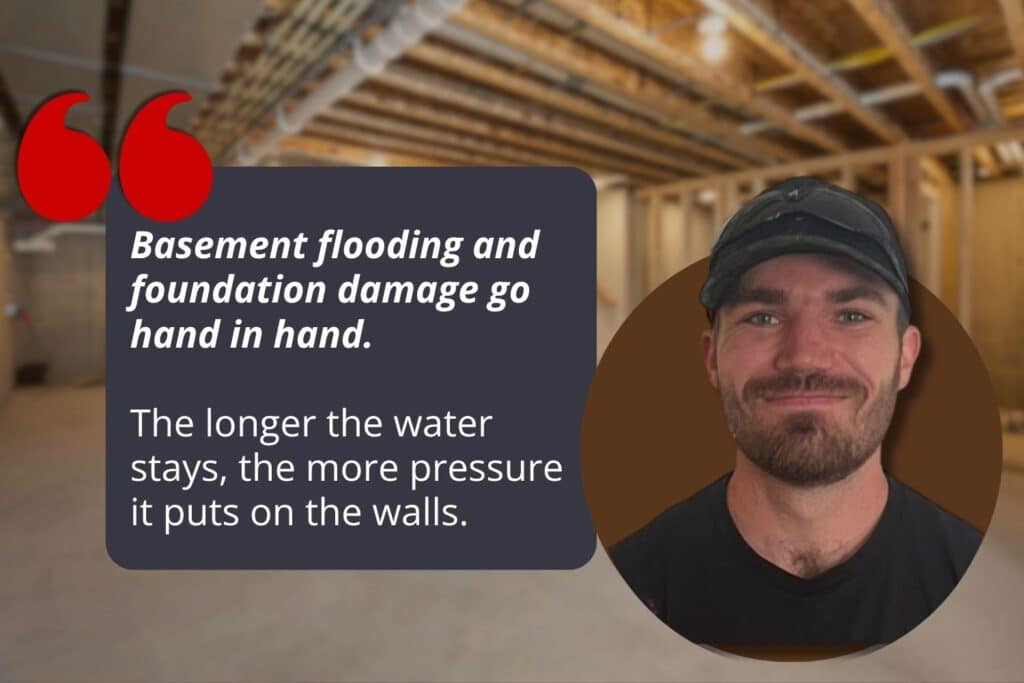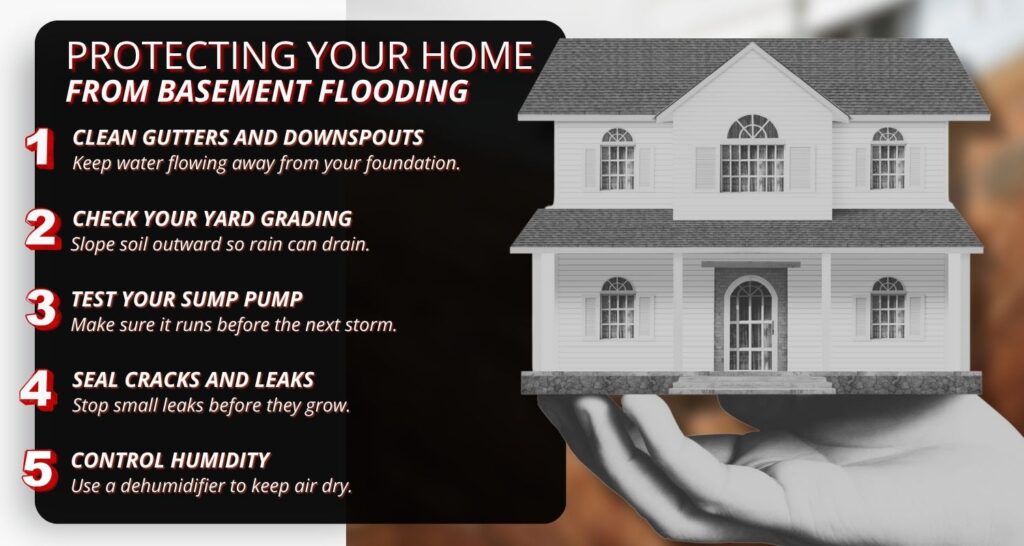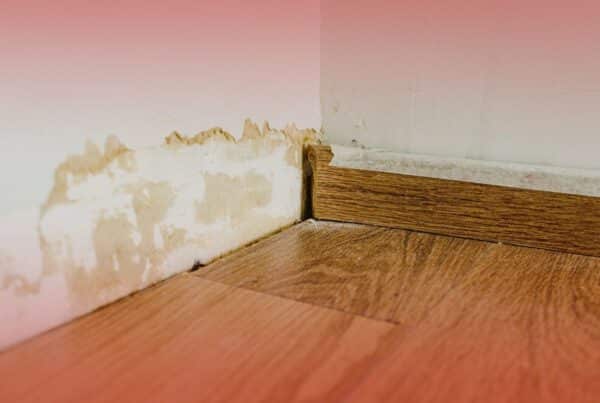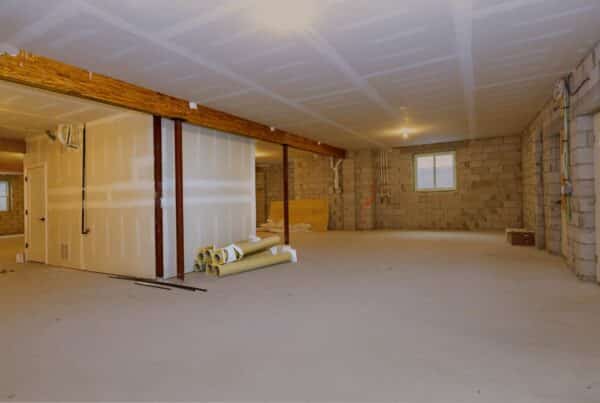This post explains how a flooded basement leads to foundation damage, what warning signs to look for, and how to protect your home in the long run.
Finding water in your basement is never a good sign. What starts as a small puddle near the wall can quickly turn into a serious foundation problem if ignored.
In Ohio, where clay soil holds water and heavy rain is common, flooding can create pressure against your home’s foundation that weakens its structure over time. Even a little water can have lasting effects.
Here’s what you should know about preventative steps, reactive action, and your home’s foundation.
Why Basement Flooding Happens in Central Ohio
Columbus homeowners deal with a unique combination of factors that make basements vulnerable to flooding.
The region’s clay-heavy soil absorbs water like a sponge and holds it against your foundation walls. Add in heavy rainfall and occasional snowmelt, and the risk multiplies.
What Are Common Causes?
- Improper yard grading that slopes toward the house
- Failing sump pumps or no sump pump at all
- Clogged gutters and downspouts
- Cracks in the basement walls or floor joints
- Leaky window wells
- Poor or missing waterproofing on older homes
According to the Ohio Department of Natural Resources, Columbus gets almost 40 inches of rainfall per year, enough to keep the ground saturated for much of the spring and fall.
That constant moisture creates hydrostatic pressure, or the buildup of water pressure against basement walls. Over time, this pressure pushes water through cracks and weak spots in the concrete.

The Hidden Link: Basement Flooding and Foundation Damage
It’s easy to think of basement water as a surface problem, but it’s usually a sign of something deeper. When water sits against your foundation for long periods, it changes how the concrete behaves.
Concrete is porous, which means it absorbs moisture. As it does, it weakens and expands slightly. During freezing weather, that trapped water turns to ice, expands even more, and begins to push the material apart.
Repeated cycles of wet, freeze, and thaw can cause cracks, bowed walls, and uneven settling.
Once cracks form, more water gets in, making the problem worse. This is why foundation issues and flooding often happen together.
You might notice…
- Hairline cracks are turning into wider gaps
- Basement walls are bowing or leaning inward
- Water seeps in after heavy storms
- Floors above the basement are becoming uneven
- Musty odors or damp air that won’t go away
The longer water sits in contact with your foundation, the faster it accelerates structural damage.
Signs Your Foundation is Already Affected
Early detection can save homeowners thousands in repairs. Some foundation warning signs are obvious, while others appear subtle at first.
What to watch for:
- Horizontal or stair-step cracks in basement walls
- Crumbling or flaking concrete
- Gaps between floors and baseboards
- Windows or doors that stick or won’t close properly
- Efflorescence (white mineral deposits left by evaporating water)
- Rusted support beams or damp framing
If you notice any of these, schedule a professional inspection.
Just one inch of water in a flooded basement can cause more than $25,000 in property damage, and that’s before structural issues are considered.
Health Risks from a Damp or Flooded Basement
Structural issues aren’t the only concern. Standing water and ongoing moisture also create an ideal environment for mold, mildew, and bacteria.
Mold spores can spread quickly through your HVAC system and into living areas above.
Common warning signs:
- Musty or earthy smells that don’t go away
- Black or green patches on walls or wood
- Rust on water heaters, furnaces, or appliances
- Increased allergy or respiratory symptoms
The EPA warns that mold growth can begin within 24 to 48 hours of water exposure. Indoor air pollution from moisture problems can be up to five times higher than outdoor levels.
Keeping your basement dry is about more than comfort; it’s about protecting your family’s health.
How to Prevent Basement Flooding
Basement flooding isn’t just bad luck. Most of the time, it’s preventable with consistent maintenance and a few smart upgrades.
Gutters and Downspouts
Keep gutters clean and extend downspouts at least five to ten feet from your foundation. This keeps water from pooling near the house.
Yard Grading
Make sure the soil slopes away from your foundation on all sides. Over time, dirt settles, which can reverse the slope and direct rainwater inward.
Sump Pumps and Backups
Your sump pump should discharge water far from the foundation and run automatically during storms. Test it regularly and install a battery backup to ensure it works during power outages.
Interior Drain Tile Systems
Interior waterproofing systems collect groundwater and channel it to a sump pit before it rises to floor level. These are especially helpful for homes with high water tables.
Exterior Waterproofing Membranes
For older or heavily leaking basements, sealing the outside of the foundation with a professional-grade waterproof membrane stops water before it ever reaches the wall.
Foundation Crack Sealing
Inject epoxy or polyurethane into cracks to prevent further leaks. A professional waterproofing company should inspect to confirm the crack isn’t structural before sealing.
Dehumidifiers
Even when basements appear dry, humidity can reach levels high enough to cause mold. Keep indoor humidity below 50% year-round.

When Flooding Becomes a Structural Problem
If your basement has flooded more than once or you’ve noticed wall movement, it’s time to address the underlying cause.
As hydrostatic pressure builds outside the foundation, it pushes walls inward and weakens them over time.
Common repair solutions include…
- Carbon fiber reinforcement: Thin, strong straps that prevent bowing or cracking.
- Steel I-beams or wall anchors: Bracing solutions that stabilize and realign leaning walls.
- Interior drain tile installation: Helps relieve pressure and redirect water safely to a sump pump.
- Exterior excavation and waterproofing: Stops water intrusion at the source.
Each foundation repair is different. A professional inspection can determine whether you need structural reinforcement, improved drainage, or both.
Why You Shouldn’t Delay Repairs
Ignoring basement water problems is one of the costliest mistakes homeowners make. A single storm can turn a small crack into a full-blown leak.
Over time, that moisture breaks down foundation materials, causes wood framing to rot, and lowers the home’s value.
- Foundation repair: Bowing walls or major structural fixes can exceed $10,000.
- Mold removal: Professional remediation costs between $1,200 and $3,800 on average.
- Energy efficiency: Damp air makes heating and cooling systems work harder, raising monthly bills.
- Resale value: Homes with known water damage can lose some of their market value.
A proactive approach saves money in the long run and keeps your foundation secure.
Local Weather and Foundation Stress
Central Ohio’s freeze-thaw cycles make foundation care an ongoing need. When water in the soil freezes, it expands and presses against your foundation. When it thaws, the soil settles and leaves gaps that let more water in.
This seasonal movement causes the kind of stress that leads to cracking, bowing, and water intrusion. Regular inspections before and after winter help identify changes early.
Simple habits to protect your foundation:
- Check basement walls each season for new cracks or moisture.
- Clear gutters and downspouts before spring and fall rain.
- Keep sump pumps tested and maintained.
- Use landscaping or downspout extensions to move water away from your home.
The American Society of Home Inspectors (ASHI) identifies soil movement as one of the top causes of home foundation problems. Staying ahead of the cycle can prevent costly repairs.
When to Involve a Professional
Call a foundation and waterproofing expert if you notice a flooded basement, or any of these signs:
- Water pooling after storms or snowmelt
- Visible cracks are widening over time
- Damp, musty smells that linger
- Bowed or leaning walls
- Uneven floors or drywall cracks above the basement
- Peeling paint or rust on support beams
Buckeye Basement Solutions inspects the full picture: soil, drainage, structural stability, and waterproofing systems. We find the source of the issue and design a plan that fits your home and budget.
Other Related Questions Homeowners Have
Can interior systems stop all basement flooding?
Interior drain tile and sump pumps handle most leaks, but heavy pressure or wall movement may need exterior waterproofing too. An inspection can confirm what’s really going on.
What’s the difference between a sump pump and a drain tile system?
A sump pump removes collected water. Drain tiles move that water away from your walls before it becomes a problem. Many homes in central Ohio need both to stay dry.
Are small wall cracks normal?
Some are. Thin, surface-level cracks happen as concrete settles. Cracks that leak or form a stair-step pattern usually mean foundation stress and should be checked.
Can basement moisture affect the rest of my home?
Yes. Moist air rises, carrying musty smells and mold spores through your HVAC system. Keeping your basement dry helps your whole home stay healthier.
Conclusion
A flooded basement is more than an inconvenience; it’s a warning that your foundation might be at risk. Water that seeps in today can weaken your home tomorrow.
If you notice cracks, damp walls, or standing water in your basement, contact Buckeye Basement Solutions.
Our team specializes in waterproofing, foundation repair, and inspections tailored to Columbus homes and soil conditions. We’ll help you protect your property and restore peace of mind before the next storm.



